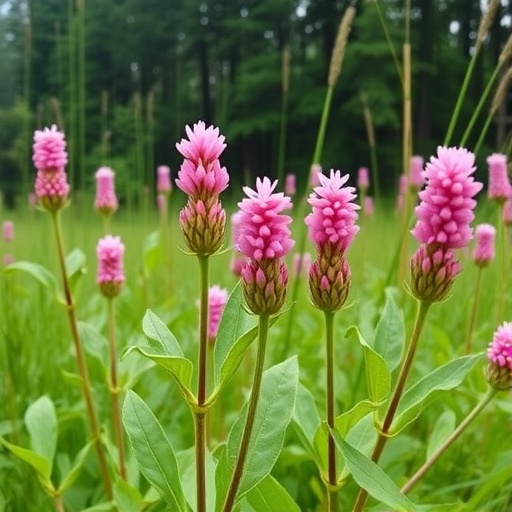In the lush, picturesque Kashmir Himalaya, red clover, scientifically known as Trifolium pratense, stands as a crucial focal point for both ecological balance and agricultural sustainability. As climate change issues intensify on a global scale, the relevance of studying this perennial legume becomes critical. Recent research conducted by J.M. Dad has unveiled significant variations in the agro-morphological characteristics of red clover, shedding light on its adaptability and distribution amidst shifting climatic conditions. Understanding these intricate dynamics not only adds depth to our knowledge of this species but also highlights the vital role it plays in agro-biodiversity.
Red clover is renowned for its adaptability to diverse environments, which makes it a staple in temperate regions of the world. J.M. Dad’s research delves into the various agro-morphological traits of this plant, such as leaf size, flower morphology, and root structure, and how these traits change in response to varying climatic factors. Traditionally, agro-morphological studies have emphasized crop yields, but Dad expands this perspective by considering the ecological implications of these traits as well, offering insights into the plant’s resilience and functionality within its ecosystem.
A key aspect of this study is the correlation between climate variants and the morphologic attributes of red clover. With rising temperatures and unpredictable precipitation patterns, the ability of Trifolium pratense to adapt could dictate its future presence in Himalayan agriculture. The research points out the critical interaction between temperature and growth rates, emphasizing that higher temperatures may initially accelerate growth but can lead to stress in prolonged heat conditions, ultimately affecting the plant’s biodiversity and survivability.
As the focus of agriculture shifts towards sustainability, red clover’s capability to fix nitrogen in the soil becomes an indispensable characteristic. The study explores how variations in morphology not only relate to climatic factors but also to soil health. Red clover’s roots can significantly enhance the soil’s nitrogen levels, making it a valuable component in crop rotation and as a cover crop in various farming systems. This functionality is particularly crucial in regions facing nutrient depletion due to conventional farming practices.
In an era when food security is of utmost concern, the implications of Dad’s findings stretch beyond academic interest; they hold practical importance for farmers in the region. As climate change continues to pose challenges, understanding the traits that allow red clover to thrive can empower local farmers to make informed decisions regarding crop selection and management. Those who harness this traditional knowledge alongside scientific insights may find a pathway to more resilient agricultural practices, thereby ensuring food sustainability.
The geographic scope of this study is particularly relevant. The Kashmir Himalaya is characterized by its unique climate and diverse ecosystems. This region serves as the eastern interface of various climatic influences, which contribute to the diverse traits observed in red clover populations. Dad’s investigations provide a detailed mapping of how various red clover traits differ across altitudinal gradients and varying agricultural practices, contributing to a broader understanding of plant distribution in response to climate change.
Moreover, the study emphasizes the importance of integrating traditional ecological knowledge with modern scientific methods. This fusion can lead to enhanced resilience strategies for local farmers, enabling them to better prepare for the uncertainties brought on by climatic shifts. The data collected may serve as a pivotal resource for developing adaptive measures that align with both sustainable agricultural practices and ecological preservation.
In conclusion, the ongoing research on the variations in agro-morphological characteristics of red clover under changing climatic conditions showcases the complexity of plant responses to environmental stressors. J.M. Dad’s work not only fills a crucial gap in the existing literature but also ignites a conversation about the critical role of adaptive crop management strategies in the face of climate change. As farmers and researchers continue to navigate these challenges together, insights such as these become instrumental in crafting viable methodologies for maintaining agricultural productivity and ecological integrity.
Through this research, the face of modern agriculture could be transformed, particularly in vulnerable regions like the Himalayas. As various stakeholders reflect on Dad’s findings, the overarching goal remains clear: to foster resilience and sustainability in agriculture while cherishing the intricate relationship between humans and their environment.
The exploration of red clover’s phenomenal adaptability not only serves as a reminder of the beauty of nature’s designs but also punctuates the urgency of understanding plant species under the duress of climatic shifts. Researchers, farmers, and policy-makers must collaborate, leveraging this knowledge to create integrated agricultural frameworks tailored to the unique challenges posed by climate change.
In essence, this investigation into the agro-morphological characteristics of Trifolium pratense underlines a profound truth: embracing scientific knowledge and traditional wisdom in tandem can lead to innovative solutions for modern challenges in agriculture, potentially paving the way toward a more sustainable future.
Subject of Research: Agro-morphological characteristics of red clover under changing climate.
Article Title: Variation in agro-morphological characteristics of red clover (Trifolium pratense L.) and its distribution under changing climate in the Kashmir Himalaya, India.
Article References:
Dad, J.M. Variation in agro-morphological characteristics of red clover (Trifolium pratense L.) and its distribution under changing climate in the Kashmir Himalaya, India.
Discov. Plants 2, 314 (2025). https://doi.org/10.1007/s44372-025-00402-1
Image Credits: AI Generated
DOI: https://doi.org/10.1007/s44372-025-00402-1
Keywords: Red Clover, Agro-Morphological Characteristics, Climate Change, Kashmir Himalaya, Sustainable Agriculture.




